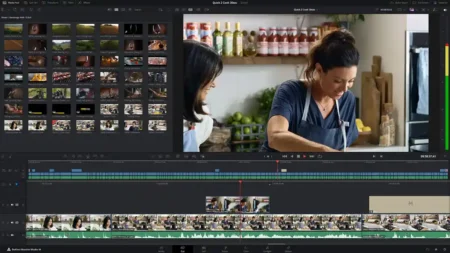Snap Verdict
Adobe Photoshop Elements isn’t a chopped-down, edited-highlights version of Adobe Photoshop. It uses a lot of the power behind Adobe’s enthusiast- and pro-level image editing software package, but it’s presented in a more task-orientated way. Its interface looks completely different and it’s more user-friendly. Aided by Adobe Sensei AI technology, it also does a great job of automating some complex tasks with the 78 Guided Edits taking you through the key stages, giving you control over the final look of your images. There are also advanced features such as Adjustment Layers for more experienced photographers.
Price
Photoshop Elements 2020 is available by itself or bundled with Adobe Premiere Elements. It can also be bought as an upgrade on previous versions (with or without Premiere Elements) at a discounted price. The prices are as follows:
- Full – US $99.99 (approx £81)
- Upgrade – US $79.99 (approx £65)
Adobe Photoshop Elements & Premiere Elements 2020
- Full – US $149.99 (approx £122)
- Upgrade – US $119.99 (approx £98)
System Requirements
Windows
- 1.6GHz or faster processor with SSE2 support
- Microsoft Windows 10 (recommended versions 1809, 1903) or Windows 8.1 (Windows 7 not supported); 64-bit versions only (32-bit not supported)
- 4GB of RAM (8GB recommended)
- 5.2GB of available hard-disk space to install applications; additional 2.4GB to download all optional content (cannot install on a volume that uses a case-sensitive file system or on removable flash storage devices)
- 1280×800 display resolution (at 100% scale factor)
- Microsoft DirectX 9 or 10 compatible display driver
- DVD-ROM drive (for installation from DVD)
- Internet connection required for product activation and content download
Mac OS
- 64-bit multicore Intel processor
- macOS v10.13 through v10.15
- 4GB of RAM (8GB recommended)
- 6.5GB of available hard-disk space to install applications; additional 2.5GB to download all optional content (cannot install on a volume that uses a case-sensitive file system or on removable flash storage devices)
- 1280×800 display resolution (at 100% scale factor)
- DVD-ROM drive (for installation from DVD)
- Internet connection required for product activation and content download
- Read our Adobe Lightroom Classic CC review
The Home Screen
Adobe revised the Home Screen for Elements 2019 and this has continued into Elements 2020. It’s designed to enable users to find the controls that they want easily and get to work on their images quickly.
The Home Screen highlights some of the new features and gives a quick route to import images and use the Auto Creation options. You can also access the Organizer, Photo Editor or Video Editor (Premiere Elements). A scrollable carousel near the top lets you browse a collection of features that you might like to try.
There’s also a search bar that directs you to online tutorials.
Adobe added the Auto Creation feature for Elements 2019, Elements 2020 now has 12 options to make it easier to create things such as a photo collage, a book or a calendar. There are also some new Guided Edit options including Painterly Effect, B&W Selection, Pattern Brush, Depth of Field, Colorize Photo that atomically colourises a black and white image, One-click subject selection and Smooth Skin that automatically smooths skin for more flattering portraits.
All this means that there are several ways to access and edit your images, it’s not a very rigid process.
The Organizer
The Organizer is the hub of Adobe Photoshop Elements and Premiere Elements. It’s where you import your images to organise them into albums and to tag them with keywords, adding information such as the people, places and events that they capture.
Although you can open images from within the Photo Editor, and you don’t need to import them, it’s easier to browse and find the image you want to work on if you’ve imported your folders into the Organizer.
If you have a large collection of images, I recommend importing a few folders at a time, or starting the importing in the evening so you can run it overnight.
Auto Creation
Once you’ve imported some images to the Organizer, you can select some and tap Create in the top right corner of the screen. This reveals a list of things that you might like to create. Simply select the one you want and you’re off.
If you’re creating something like a book or a calendar, Elements 2020 presents you with a small selection of templates to choose from. It’s disappointing to find that most of these are quite busy. The only clean, simple option is the Monochrome theme, but even that alternates between white and black page backgrounds. If you want to show all your images on a plain white background, you’re out of luck. Hopefully, Adobe will resolve this with a future update.
The photo book creator offers a selection of different page layouts, and you can drag images around on the page, but it’s not obvious how the alignment tools work. It’s nice for creating a book quickly, but it’s no replacement for a professional album creation tool like Fundy Designer.
In the US, there’s the option to create Fujifilm products and have them printed, but that functionality has yet to reach the result of the world. In the UK, Europe and everywhere outside of the US, you have to print your creations on your home printer, or send them to you favourite lab via their website.
Photo Editor
If you opt to open the Photo Editor Direct from the Home Page, you have the choice of using the Quick, Guided or Expert controls. These are selected by clicking on the options at the top of the screen.
The Quick controls are the easiest to use. When this tab is selected, you can pick from a collection of filter effects (in a column on the right) to apply to your image. A dropdown box in the top left corner of the screen lets you choose whether to see the ‘after’ image, the ‘before and after’ image, or just the ‘before’ image. Helpfully, you can arrange to before and after images side-by-side or one above the other.
A small collection of tools on the left of the screen is provided to make selections, enhance eyes, whiten teeth, straighten the image, add text, clone out unwanted objects or spots, crop the image or move selected elements.
Clicking on the Guided tab allows you to browse the 78 options that are available. As well as the new features I mentioned earlier, there are edits to help you do things like resize your image, adjust the exposure, create monochrome images and merge multiple shots of a group of people to create one nice image.
The Expert section is the more traditional image-editing area. There’s a large preview at the centre of the screen and a collection of tools on the left. As soon as you select a tool, its controls appear at the bottom of the screen. Helpfully, you can hop between the different editing tabs while you work on your image.
Guided Edits
As the name suggests, the Guided Edits are step-by-step wizards that take you through the process of making various adjustments to your image. These explain in clear language what you have to do, whether it’s using a brush to paint over an object that you want to remove, or dragging a level along a straight edge.
While some of the Edit options are a bit cheesy, there are others that are very useful. Anyway, we all like a bit of cheese now and again.
The auto-selection tools don’t always get everything absolutely right, but they often do good job. You need to be especially careful where fine objects such as grass cross over the subject that you’re aiming to select, but a few minutes working with the refining tools usually gets things looking good.
Once you’ve finished making one Guided Edit, you can select another to make further adjustments to your image.
Expert Editing
If you select a raw file to open in the Editor, it automatically opens Adobe Element’s version of Camera Raw. This has a more limited range of controls than Photoshop’s version, and than Adobe Lightroom, but you can adjust key aspects such as the exposure, white balance, saturation and contrast (to name just a few). Notably, there are no local adjustments.
Tapping ‘Open Image’ in Camera Raw, opens the raw file in the Expert editor area. You can also opt to open Jpeg files here.
Critically, the Expert area lets you work with adjustment layers, which means you can apply edits to a layer and then revisit them. You can also apply a mask to the adjustment layer and edit it with the brush or gradient tools so the adjustment is applied where you need it. For example, you can apply a Brightness and Contrast Adjustment Layer and use the mask editing tools so that the ground stays as you captured it but the sky is darkened.
Helpfully, you can also tap on the Guided tab at the top of the screen to access the Guided edits if you need to tackle a tricky adjustment that you’re not comfortable with. These edits are applied as new layers, which means you can turn them off or reduce their opacity when you return to the Expert area.
Verdict
Adobe Elements 2020 is easy to use and gives lots of control over your images. It has a comprehensive array of features and is far less intimidating than Adobe’s pro-end software. Elements is aimed at consumers rather than enthusiast photographers, but features such as the Adjustment Layers are attractive to keen photographers. However, as Elements retails for $99.99 (approx £81), it’s well worth looking at the Adobe Photography Plan which costs $9.9/£9.98 per month and includes Lightroom and Photoshop. But if you’re adverse to a subscrpition model and want to use an Adobe product, Photoshop Elements makes a good choice.
While I think Elements 2020 is an excellent image-editing software package, Adobe needs to offer a few simpler templates for its Creations. Not everyone wants faux fabric and texture effects behind their images.


